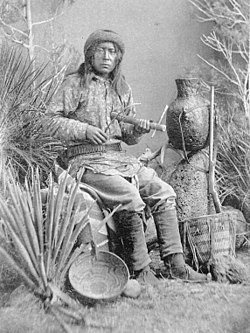

The Apache fiddle (Apache: tsii' edo'a'tl, "wood that sings") [2] is a bowed string instrument used by the indigenous Apache people of the southwestern United States. The instrument consists of a plant stalk, such as that of the agave or mescal plant. One or sometimes two strings, often made of horse hair, are secured at both ends of the stalk, a bridge and nut added, and the string is played with a bow resined with pine pitch. [3] The string is touched with the fingers to change its note. The Smithsonian Institution holds an Apache fiddle collected in 1875. [4] In 1989 Apache fiddle maker Chesley Goseyun Wilson of Tucson, Arizona won a National Heritage Award. [5]